Do-it-yourself air humidifier: device options and manufacturing instructions
It is not for nothing that a lot of attention is paid to maintaining air humidity in a living room, as it affects human health.But what's the point of paying for an expensive device if you can assemble a humidifier yourself? It will not be inferior in performance to its factory counterpart.
There are several types of devices that can be made literally “on the knee”. In this article, we examined the principles of operation of household humidifiers and how to make them yourself.
Popular and effective methods of creating conditions for better evaporation associated with heating water and exposing it to air flow are considered. We will also show you how to assemble a homemade device based on an ultrasonic nebulizer.
The content of the article:
Dry air problem
Humidity, temperature and oxygen concentration are the most important parameters of the microclimate of a living space, on which a person’s well-being depends. In winter, indoors, the water content in the air decreases. This is an easily explained physical process, the consequences of which can be eliminated with fairly simple actions.
Causes of lack of moisture
In a climate of moderate humidity, characteristic of most regions of Russia, dryness in the room occurs during the cold season. It is caused by a simple physical phenomenon: the volume of water required for one hundred percent humidity decreases as the air temperature decreases.
Thus, cold air coming from the street carries very little water into the room.And the warm flow emanating through the ventilation system can carry away several times more. This leads to imbalance.
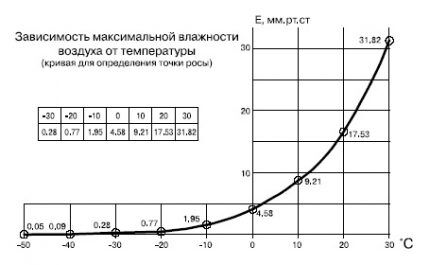
Partially, the lack of moisture is compensated inside the apartment due to the following phenomena:
- availability of open water sources;
- evaporation of moisture from washed dishes and laundry;
- breathing of humans and domestic animals;
- watering flowers, wet cleaning.
Often this cannot completely restore the humidity to the desired values. In regulatory documents such as SNiP 41-01-2003 “Heating, ventilation and air conditioning” and SanPiN 2.1.2.2645-10 “Sanitary and epidemiological requirements for living conditions in residential buildings and premises”, optimal relative humidity indicators are set in the range of 30-45 %.
In this regard, residents are making attempts to achieve standard indicators through some kind of adaptations. There are many on the market now household humidifiers.
However, high-quality devices are not cheap and require maintenance. Therefore, many are inclined to alternative methods of saturating the air with water or to making homemade devices.
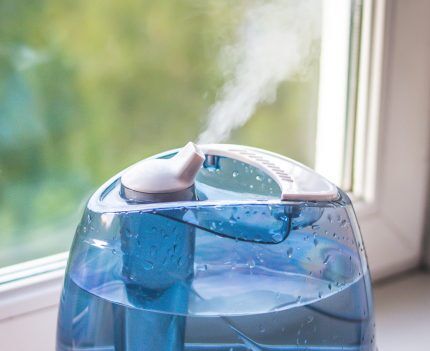
So, the main reason for dry indoor air is the flow of air with a very low moisture content. However, there are theories that some devices (heating radiators, oil heaters, convectors, incandescent lamps) “dry” the air.
This myth-making is supported by heating equipment manufacturers and “advanced” managers to increase sales of expensive appliances.
There can be no physical basis for the disappearance of water molecules in a living space if there is no portable hadron collider or an artifact of an alien high-tech civilization.
The chemical reaction of water binding due to intramolecular interactions (hydration) occurs in such an insignificant amount that it can be neglected. Therefore, you can only “save” on ventilation, but this will lead to an imbalance in the oxygen balance. There is only one thing left - compensation for moisture loss.
The simplest methods of increasing air humidity
The problem of dry air has been known for a long time, so there is experience increasing humidity in such elementary ways:
- Hanging wet fabric on ropes. Evaporation occurs intensely, but the material dries quickly. In addition, laundry takes up a lot of space.
- Installation of filled containers with a large evaporation area. These are usually basins, although an aquarium can also be used if the top glass is removed.
Having a lot of plants in your home also increases humidity. They have to be watered frequently, which causes water to enter the air through the leaves (transpiration).
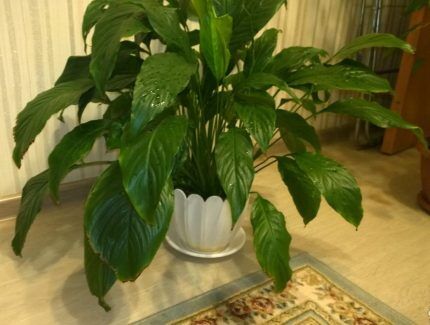
Wiping the floor and interior items with a damp cloth gives an effect similar to hanging a wet cloth: the air is quickly saturated.Therefore, you should not neglect this type of cleaning, especially in winter.
Making homemade humidifiers
Simple evaporation has a disadvantage: either the process is too slow, or it is necessary to occupy a large area for the “evaporator”.
To solve this problem, they use an increase in the rate of water entering the air by heating or blowing it. Since such air humidifiers are easy to make with your own hands, you don’t have to spend money on purchased products.
Using radiators
Water, which has a temperature higher than the surrounding air, evaporates much more intensely. A heating system is usually used as a heating element. Its main advantages are that it does not require additional energy consumption and works all the time.
You can ensure a constant supply of water to the radiator in the following way: place a container under the battery, into which a rag is lowered, the upper part of which is tied to the radiator. As a result of the capillary effect, water rises, heats up and evaporates.
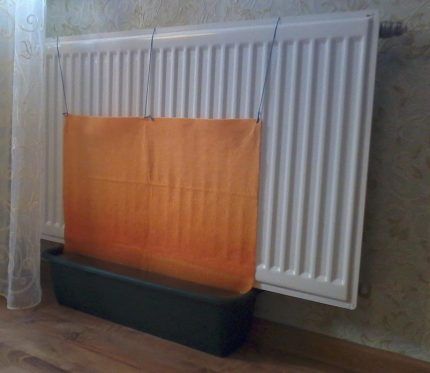
A similar, but slightly more complex design can be made for a heating pipe. To do this, use an ordinary plastic bottle with a hole cut in the side. The container is secured with wire or other durable material. A rag is tied to it, through which water will flow.
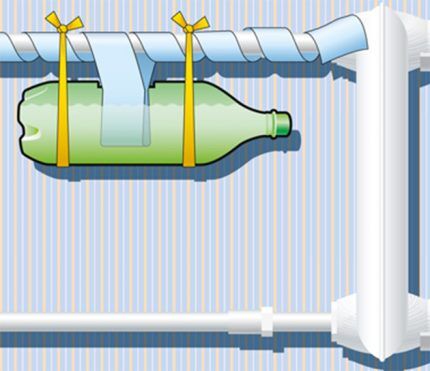
There are many containers on sale for air humidification that are attached to the front of radiators. You can make the same design yourself from plastic bottles.
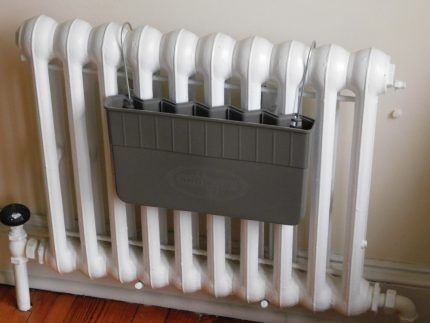
You can also place a container of water on the battery. The lower the liquid level, the faster it will evaporate. The housing material can be anything: the main thing is that it has high thermal conductivity.
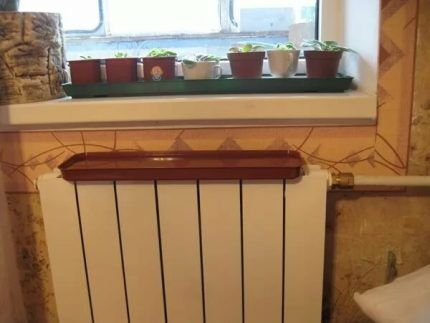
These methods work well for heating radiators with a temperature of 60-80°C. They should not be used for stoves or boilers where the body temperature is much higher, as the rags or plastic will catch fire.
Evaporation using ventilation
Air saturation with moisture occurs much more intensely when exposed to wind. This factor is used in homemade air humidifiers, which are easy to build with your own hands if you have a fan.
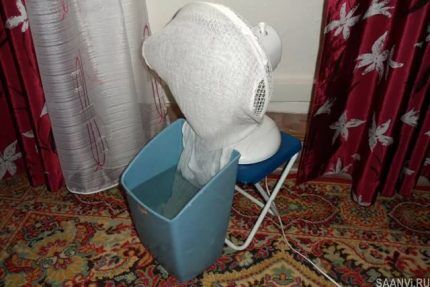
A homemade humidifier with a fan works on the following principle: an air flow enters the container through the inlet, raises moisture and exits through holes specially made for this purpose.
Usually a plastic bottle with a volume of three liters or more is used as a vessel.To organize the flow, a computer cooler operating on 12 or 24 volts is most often used.
The most difficult thing in the practical sphere is to securely fasten the fan and ensure tightness so that moist air does not escape back and does not fall on the blades and current-carrying parts.
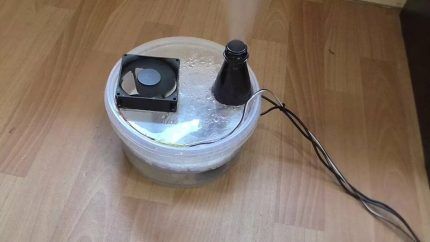
The main disadvantage of such humidifiers is the noise from the operating fan. Electricity consumption for standard cooler models is low and ranges from 3-6 watts.
Using ultrasonic nebulizers
The most productive are ultrasonic humidifiers with built-in cold water sprayer. It can be purchased in specialized stores or on well-known online sites.
To assemble a simple ultrasonic humidifier you will need:
- ultrasonic nebulizer designed for a volume of 0.3 l/hour (its cost together with the power supply is about 500 rubles);
- cooler from a video card or processor (price – 150 rubles);
- plastic container (price - 70 rubles).
The ultrasonic sprayer needs to be glued to the bottom of the container, and a hole must be cut in the lid above it, to which a hose can be attached. Such a device will cope “excellently” with humidifier functions, embedded in factory-made units.
It should not be too long so that there is no condensation effect. We cut out the second hole for the cooler and install it in such a way that it directs the air flow inside the container.
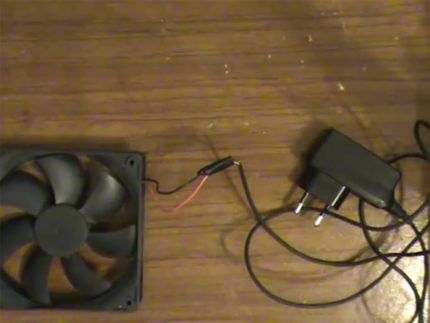
You will have to make another hole in the cover for the power wire from the sprayer. As a result, the ultrasonic sprayer will create cold steam, which will be blown out by the flow created by the fan.
This model has one serious drawback. With natural cold evaporation, clean water rises into the air, while the ultrasonic atomizer, creating a “fog” of tiny droplets, also captures dissolved elements.
If humidifier use Often, calcium salts in tap water, settling on interior items, create a white coating visible to the eye. It is not dangerous to health, but you have to constantly clean it. Therefore, devices based on an ultrasonic atomizer must be filled with filtered or distilled water.
Evaporator in duct ventilation
If the area of an apartment or private house is large, the problem of air humidification using several separate devices arises. You need to not only buy them or make them yourself, but also constantly monitor the availability of water and the quality of work. In this case, installing one device in the supply ventilation duct will help.
You can independently make a humidification unit that works either on the principle of creating “fog” with an ultrasonic evaporator or uses the idea of passing a flow through a wetted barrier. In the second case, the larger the blown area of the wet surface, the greater the volume of evaporation.
There are two fundamentally different approaches to wetting a blown barrier.You can make a rotary type installation, the lower part of which is in the water. As a result of rotation, the “disks” become wet, through which the flow of supply air passes.

You can also buy a barrier in the form of a cellular cassette. With the help of a pump, water is supplied to the sprinkler, which flows down, evaporates and enters the room through the ventilation system.
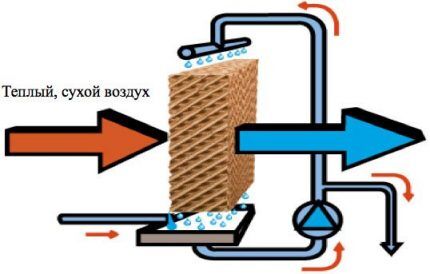
It should be remembered that when using duct humidifiers, it is necessary to periodically carry out procedures aimed at disinfecting the unit from pathogenic organisms. This includes treating with biocides and draining the system when it is not in use.
Conclusions and useful video on the topic
Humidifier from a plastic bottle using a computer cooler:
Humidifier using ultrasonic evaporator:
Manufacturing a duct humidifier based on cellular cassettes:
To make your own household air humidifier, you do not need special skills or expensive materials and components. Most likely, the design of the device will be less elegant, but its functionality will be similar to the factory device. In addition, in the event of a breakdown, a homemade product is easier to repair.
Would you like to share a version of a humidifier of your own invention or manufacture? Do you have useful information on the topic of the article that is worth sharing with site visitors? Please leave comments in the form below, post photos and ask questions.



